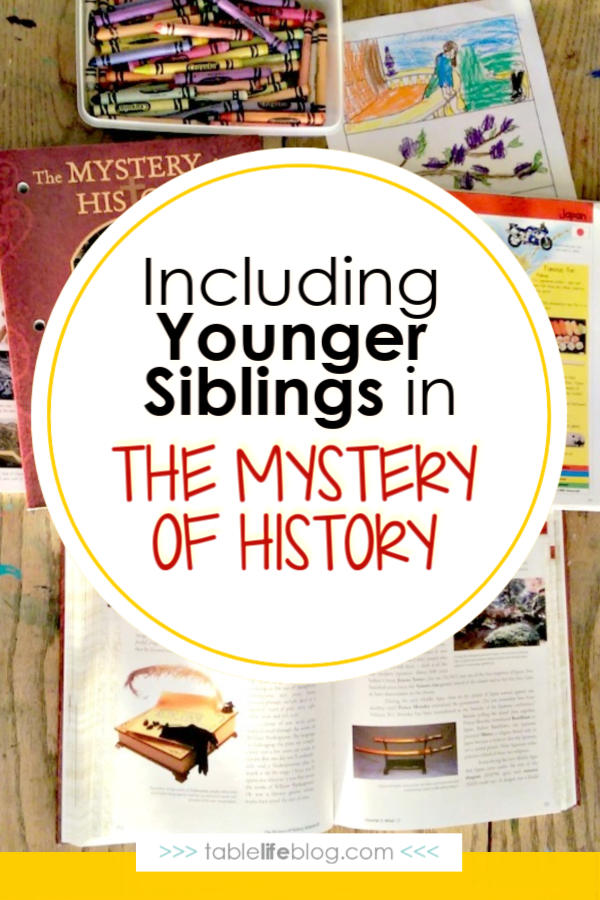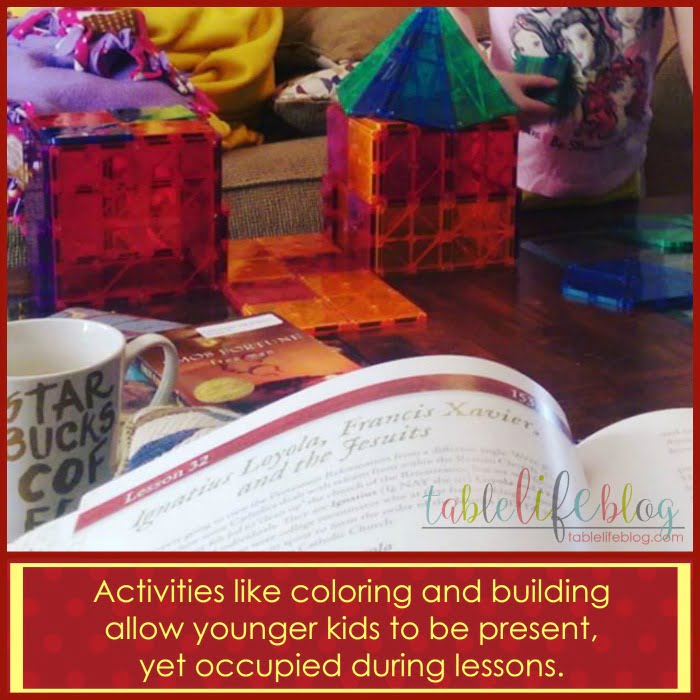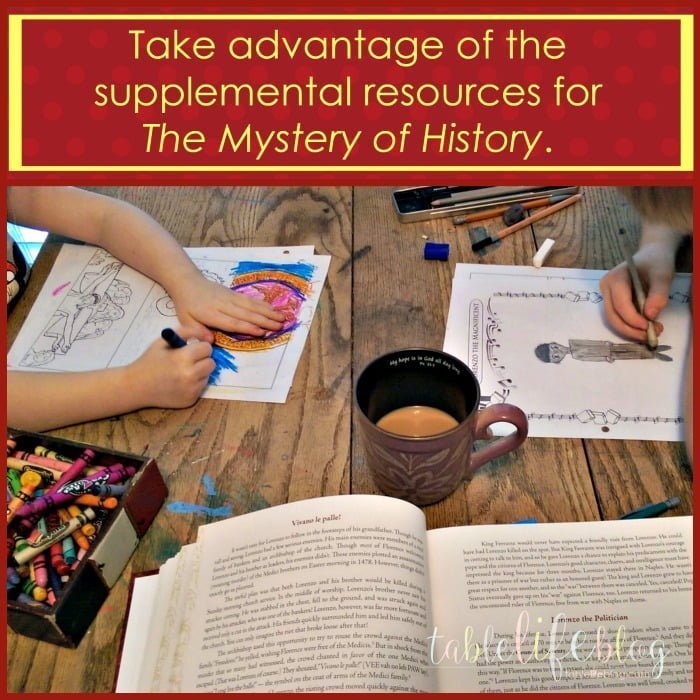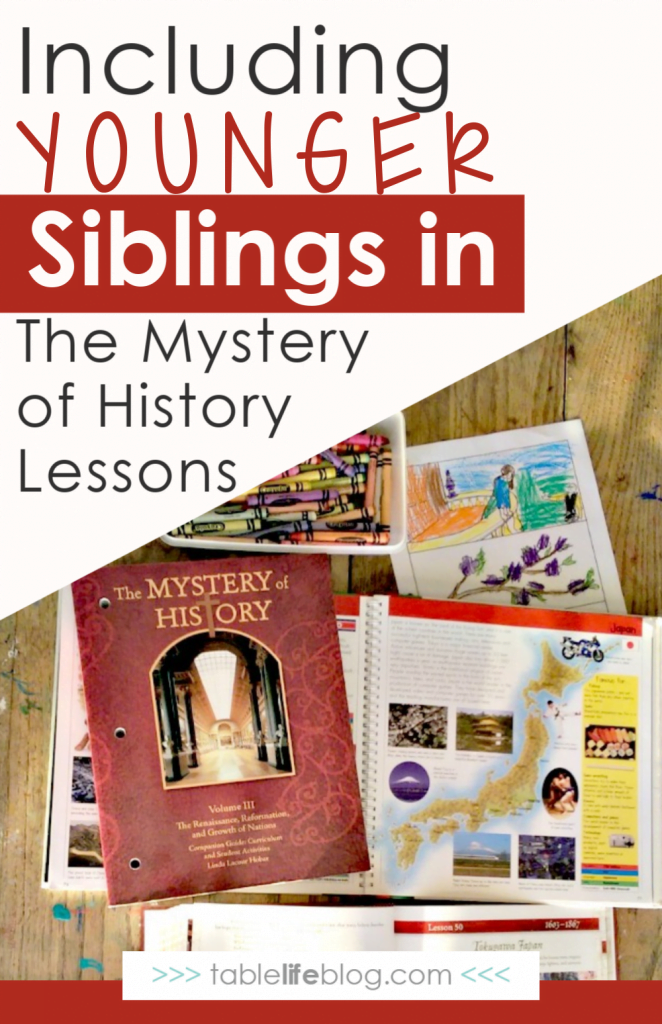Are you considering The Mystery of History for your homeschool, but aren’t sure how to make it work with the younger ones in your family? Good news: today I’m sharing three easy ways to teach your older kids and also include younger siblings in The Mystery of History lessons.


*Post contains affiliate links; see disclosure for details.
I’ve mentioned before how The Mystery of History is a homeschool favorite for my family. We’ve been using it for our history spine for a few years now and look forward to our lessons each week. That said, using The Mystery of History with my ten-year-old son is always great, but using it with my five-year-old daughter hasn’t always come as intuitively.
Thankfully I’ve picked up some ideas over our time using this fantastic curriculum and it’s easy to include my little one in these lessons now.
Including Younger Siblings in
The Mystery of History Lessons
Before I share these ways to include younger children in The Mystery of History, keep in mind that this is primarily about laying a history foundation for them. The beauty of the classical history cycle is that all of these themes and lessons will show up again when they’re older and able to understand even more.
Don’t stress over retention or even interest. Instead, let them participate in a way that meets them where they are. Here’s a look at the ways we approach that in our homeschool:
1. Keep little hands busy
Keeping little hands busy during lesson time is essential for including younger siblings in your history lessons. We approach this a few ways in our home. One easy way is to let my daughter build or play quietly in the room while we’re reading a lesson or discussing. LEGOs and PlayMags (pictured below) are some of her favorite toys to enjoy during lesson time.
Another way to keep younger siblings busy while working in The Mystery of History is to have them color or draw while you read aloud. That allows them to be present, but otherwise occupied if the lesson is a bit over their heads or too lengthy for shorter attention spans.


Lastly, we often read our history lessons at lunchtime to keep my youngest happy while we’re tackling the reading portion of the lesson. This may not be as easy for larger families, but it works well for us and is an easy way to work The Mystery of History into our homeschool day.
When this happens, we head off the different rooms when the lesson and lunch are finished. My big kid does his independent history work at this time and my little one prepares for nap. This is a good compromise for our family makeup because we can be together when it matters most and allow time for concentration and review as needed.
2. Connect the dots
Another great way to include younger siblings in lessons from The Mystery of History is to simply help them connect the dots. They may not understand the full scope and impact of the events and key figures from each lesson, but giving your younger children a point of reference goes a long way.
For example, use a globe or map to help your little ones trace travel routes for explorers. Use books to show them examples of the ships and travel resources available in the time periods you’re studying. This helps them understand how different the world was and grasp the challenges involved in living in a different time and place.
You can also use picture books or educational videos to help your young ones connect the dots. Here are a few ideas to consider:
- The You Wouldn’t Want to Be series provides tons of information about history topics, but does so in a way that’s engaging for young learners.
- Picture books that are centered around a certain place help engage younger children beyond the happenings in your history lessons. This helps them connect the dots between some of their favorite stories and the real-life happenings that took place in their settings. For ideas, see these children’s books about Italy.
- Episodes from a show like Once Upon a Time Explorers can be used in addition to lessons from The Mystery of History. This is especially helpful for visual learners and, an added bonus, are available for streaming through Amazon Prime Video
.
3. Enjoy supplemental resources from
The Mystery of History line
One of my favorite things about The Mystery of History is that it’s more than a textbook. Sure, the text is engaging on its own and keeps us looking forward to more, but the product line has several gems that make it easy to include younger siblings in the lessons.
Companion Guides
One of these gems is the Companion Guide that goes with each volume of the curriculum. This guide is included in the text in Volumes II and IV, but is sold separately for Volume I and Volume III.
These companion guides are helpful for teaching multiples ages since they include review pages, pretests, and quizzes. However, they’re specifically helpful for including younger siblings because there are activities to go along with each lesson. There are activities for all ages, but there are also targeted activities younger students, middle students, and older students.


Super Supplemental Collections
The Super Supplemental Collections also make it easy to include younger children in your lessons from The Mystery of History. I love the customization these collections allow. The collections come with challenge cards, folderbooks, multiple notebooking page options for each lesson, and matching coloring pages. You can understand why they rock my homeschool each day, right?
It doesn’t sound like a big deal, but these supplemental resources makes it easy to include younger siblings because they’re able to engage on their levels.
For example, my five year-old enjoys the coloring pages and the open notebooking pages that go with each lesson. While she’s not quite ready to write summaries or answers to questions, she can color the lesson’s matching coloring page or draw a picture about the lesson.
So, why not grab notebooks and take the DIY route or search for printable freebies instead of using these supplemental resources? You could go that direction, but that old expression “you get what you pay for” applies here.
These collections are designed to accompany the curriculum and nothing you piece together will compare. Add that to the fact that the supplemental collections allow you to print and go and you can see why they’re a great match for a multi-age homeschool. I mean, since when do busy homeschool parents need busywork? ;)
You can learn more about each collection through the links below:
- Super Supplemental Collection for Volume I, Creation to the Resurrection
- Super Supplemental Collection for Volume II, The Early Church and the Middle Ages
- Super Supplemental Collection for Volume III, The Renaissance, Reformation, and Growth of Nations
- Super Supplemental Collection for Volume IV, Wars of Independence to Modern Times


In closing, I hope you’ll find these ideas helpful and that they’ll make it easier to engage all of your kids while working through The Mystery of History in your homeschool.

I love all the extra things available to go with MOH these days! None of that was around when I went through it the first time, but we’ll look forward to using quite a bit of it this time. My kids are 16, 14, and almost 9yo twins, and we’ll be starting volume 1 this fall.
As a side note – what are those see-through blocks in the picture for letting the kids play while you teach?
Those are MagnaTiles (also known as Play Mags). They’re great to use during read aloud time!
These are great ideas! Out of curiosity how old was your son when you started using The Mystery of History with him?
I believe he was nine when we started, but I’m not positive. It gets hard to keep up with when you’re homeschooling year-round. ;)